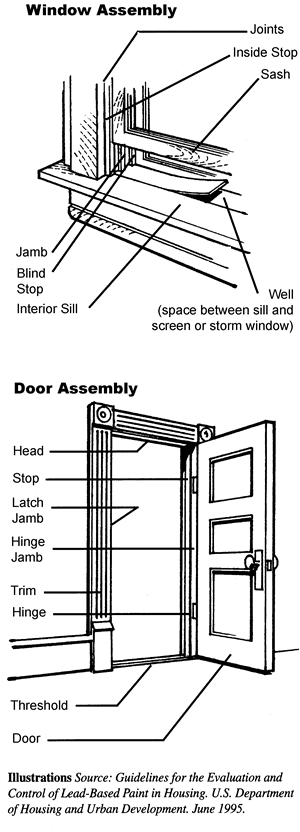Lead
- Lead Home
- Common Sources of Lead
- Contractor Information
- Educational Materials
- Factsheets, Videos and Brochures
- Lead Contractor Search
- Lead Individual License Search
- Lead Licensing
- Health Care Professionals
- Home Owner Information
- Laws and Rules
- Rule Revision: Lead Laws and Rules
- Lead in Schools
- Lead Resources
- Lead Reports
- M-CLEAN
- File a Complaint Related to Lead
- Lead Contacts
Related Sites
- Birth Defects Monitoring and Analysis
- Children's Environmental Health
- DWP Fact Sheets
- Individual and Family Health
- Lead in Well Water
- Nutrition: Healthy Eating
Environmental Health Division
Replacing Doors, Windows and Trim
Worried about lead in your home? If you are living in an older establishment you should be informed. Lead can be a serious danger. With this information, developed for property owners, renters, and contractors, learn how to safely remove doors, windows, and trim covered with lead-based paint.
The dangers of Lead
Lead poisoning is a concern for both children and adults. It can cause:
- Permanent problems with health, learning, and behavior in young children.
- High blood pressure, kidney damage, and fertility problems in adults.
You can be exposed to lead any time you breathe lead dust, fumes, or swallow anything that contains lead.
About 75% of homes built before 1978 contain some lead-based paint. The older the home the more likely it is to contain lead-based paint. You should assume that any home built before 1978 contains some lead. To be sure, test your home for lead following the advice found on the MDH web page Lead Paint Testing.
You can protect yourself from lead by following the appropriate remodeling safety procedures.
Go to > top
Before you begin
Follow these steps to ensure a safe and prepared remodeling experience.
- Identify the source in your home that caused the paint to chip or peel (ex. plumbing problems, window condensation, leaky roof, any cause of water damage, etc.).
- Be sure to fix these problems before you begin to remove or cover the old paint. Do not paint over chipping or peeling paint or the new paint will chip off with the old paint.
- Remove everything from the work area, including furniture, so these items do not get covered with lead dust.
- Any items, such as bookcases or large furniture, that can’t be taken out of the room should be covered with one-mil polyethylene (poly) plastic sheeting and sealed. You can find one-mil poly at most hardware stores. The poly will help protect the items from being covered in lead dust.
- Turn off all the heating, air conditioning, and ventilation systems in the home. If the work is being conducted in the winter use caution when you turn off the heating so the water pipes don’t freeze.
- Close, cover, and seal the registers to prevent lead dust from settling in the ducts.
- Turn off window unit air conditioners and fans in the work area.
- Cover and seal the window units with one-mil poly. Remember to uncover the window units when the job is completed.
- Close, cover, and seal any unused doorways in the work are with a layer of one-mil poly.
- Cover the doorways you will be using by hanging a layer of one-mil poly over the doorway. Seal this poly to the doorway with duct tape. Then use a utility knife to cut a six-inch foot vertical slit in the middle of the poly piece to provide access to the work area.
- Attach a second piece of poly to the top of the doorway with duct tape to act as a flap. This will limit the airflow between the work area and the rest of the house.
Go to > top
On the job

Removing Doors
This procedure can be used on interior and exterior doors. The door assembly includes the jambs, stop, threshold and trim.
- Remove the hinge pins.
- Carefully remove the door from the frame.
- Wrap and seal the door in six-mil poly to prepare for disposal.
Removing Windows
The window assembly includes the sash, jamb, stops, sill and well.
- Wet mist the surface with water to keep down the dust.
- Cut all painted joints to avoid chipping the paint.
- Remove all the parts necessary to remove the sash.
- Remove the window sash.
- Install jamb liner and a new sash.
- Cover the blind stop and window well with aluminum coil stock. You can buy aluminum coil stock at a building supply store.
Removing Trim and Frames
This procedure can be used to remove baseboards, or interior or exterior trim pieces around doors and windows.
- Mist or dampen the painted surface with water.
- Cut the painted joints with a sharp knife so that you do not break intact painted surfaces around the trim or frames.
- Remove the painted trim or frame from the surface. Sometimes you may want or need to remove the entire frame.
- Wet mist the area with water.
- Carefully remove the trim and frame, to minimize the amount of lead dust created.
- Wrap and seal trim and frame in six-mil poly to prepare for disposal.
Be sure to turn off the electricity at the fuse box before you mist a surface with an outlet! Put tape over the outlet to keep water out of the outlet.
Go to > top
Clean-up
Once the door, window or trim is removed, follow the cleaning procedures on the Minnesota Department of Health (MDH) web page, Lead Waste Clean-Up and Disposal.
Go to > top
How do I get more information?
For more information about lead please contact the Lead Program at MDH. You can contact us by calling (651) 201-4620, or by visiting our Lead Poisoning Prevention website.
Lead is a risk for both you and your family. Be informed. Be safe.
Go to > top